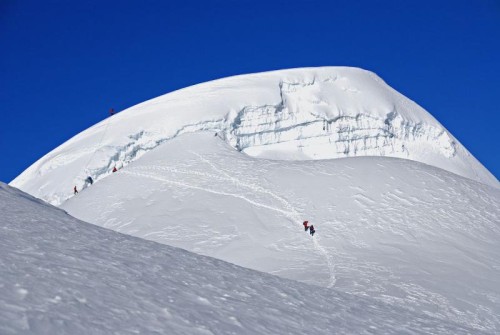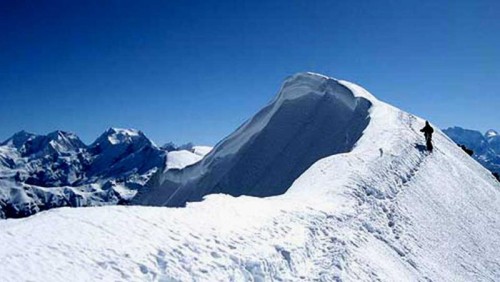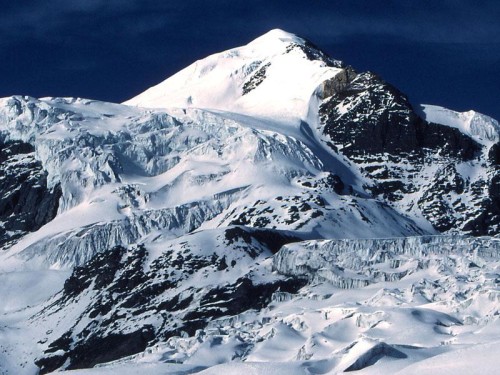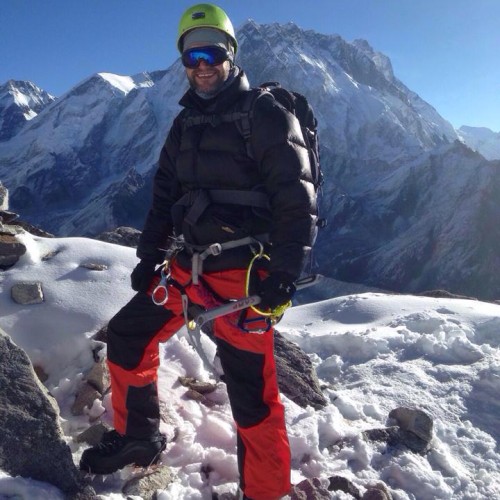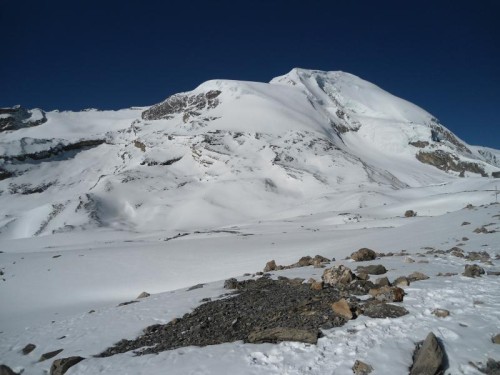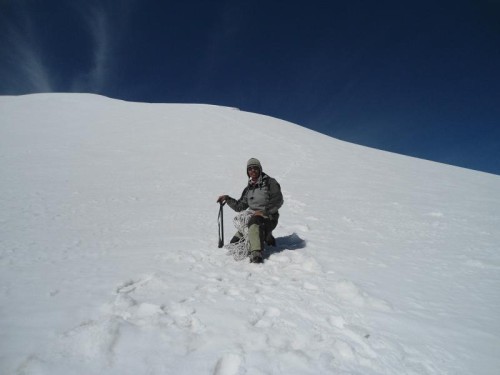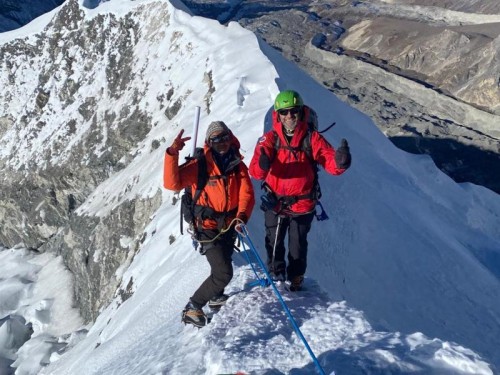Benefits of Booking Chulu East Peak Climbing with HPA
- Quick response to all inquiries by email, WhatsApp, and Messenger
- Provides clear details of the trekking package, including transparent cost breakdowns
- Offer tailored itineraries based on client preferences and fitness levels with comprehensive package services.
- High Pass Adventure prioritizes safety with well-trained guides, first aid kits, and emergency evacuation plans.
- Flexible and easy booking, reservation, and payment system
- To meet all customers at Kathmandu International Airport for pickup and drop-off services
- First aid medical kit and oxy-meter for checking pulse, heart rate, and oxygen saturation at higher altitudes during the trek, which may be necessary in certain cases
- Regular health checks and acclimatization schedules minimize the risk of altitude sickness.
- Easily arranges all logistics to ensure a hassle-free experience in Nepal for all clients
- Complimentary extra luggage storage service provides throughout the trek
- Arrangements of sleeping bag, down jacket, duffel bag, and walking pole (if you don't have your own)
- Company T-shirt and warm hat as souvenirs for trekking, along with a tour certificate upon completing the trip
Chulu East Peak Climbing Overview
Chulu Peak is located in the Annapurna region and consists of four peaks situated to the northeast of Manang Valley on the Chulu Mountain range. These peaks include Chulu West (6,419 meters), Chulu Center (6,584 meters), Chulu East (6,429 meters), and Chulu Far East (6,429 meters). Among them, Chulu West Peak and Chulu Far East Peak are particularly famous for climbing.
Chulu West Peak is a bit more challenging to climb compared to Chulu East Peak, but both offer a similar adventurous experience. For those looking to climb a Chulu Peak, we highly recommend Chulu Far East, as it is more famous and accessible than the others in the Annapurna region.
Chulu East Peak is an attractive climbing destination for climbers seeking a challenging yet rewarding experience. It offers adventure amidst beautiful natural scenery, including forests, hills, and high-altitude terrains, with views of snow-capped mountains. Additionally, climbers can experience the culture and lifestyle of the local communities by passing through several villages of Chhetri, Gurung, Magar, Manangis, and Thakalis.
The route traverses the popular Classic Annapurna Circuit Trek in the Annapurna Conservation Area, which is rich in flora and fauna. Trekkers and climbers may encounter wildlife such as blue sheep (mountain sheep), Himalayan thaar (mountain goat), deer, marmots, and various bird species, making the journey even more enjoyable.
The Chulu East Peak climb involves technical climbing from the high camp, including a steep ascent on rocky, glacial, and icy terrain, requiring proper climbing equipment, good physical fitness, and strong determination. The views from the summit of Chulu East Peak are breathtaking, offering panoramic vistas of the Annapurna range, Dhaulagiri, Manaslu, Mustang, and surrounding peaks.
After summiting Chulu East Peak, there are two options for returning to Kathmandu: one is to cross the popular Thorong La (5,416 meters) Pass and reach the next valley in Lower Mustang, and the other is to retrace the same route back to Kathmandu. Therefore, the Chulu East Peak Climbing trip starts from Besisahar and ends either in Jomsom-Pokhara or by returning to Besisahar.
Chulu East Peak Climbing Route
Chulu East Peak ((6,429 meters) is becoming famous peak in the Annapurna region, offers a thrilling climbing adventure as part of the Annapurna Circuit Trek, which begins in Dharapani and ends at Pokhara. The journey starts with an exciting drive through villages, hills, and mountains from Kathmandu and continues up the Manang Valley in the Annapurna region. The Annapurna region is famous for its stunning mountains and peaks including Chulu East Peak, as well as its rich flora, fauna, and cultural heritage of Buddhism and Hinduism.
Dharapani (1,900 meters) is the starting point for Chulu East Peak Climbing and the Annapurna Circuit Trek, as well as the ending point of the Manaslu Circuit Trek. It typically takes 7 to 8 hours to drive there from Kathmandu.
From Dharapani, the trek begins with a walk up to Ngawal, which is on the route to the Annapurna Circuit Trek or can be reached from Kangla Pass after visiting the Nar Phu Valley. Ngawal is also the starting point for the Chulu East Peak Base Camp. Trekkers typically spend two nights along the way in Chame and Pisang before reaching Ngawal from Dharapani
The route passes through lush subtropical forests, terraced fields, and picturesque villages such as Bagarchhap, Danaque, Timang, Chame, Dhukur Pokhari, Pisang and Ghermu before reaching at Ngawal. Along the way, you'll traverse bamboo, rhododendron, pine, and alpine forests, as well as high-altitude terrains. The trail follows the Marsyangdi River, but for the most part, you will walk on the road until you reach at Pisang. The trail offers stunning views of Lamjung Himal, Annapurna II, III, and IV, Gangapurna, the Manaslu mountain range, and other surrounding mountain ranges.
Ngawal is an ideal place for an acclimatization day before pushing towards Chulu East Peak Climbing. After spending a day acclimatizing in Ngawal, the trail leads to Chulu East High Camp for an overnight stay. Along the way, trekkers spend one night at Yak Kharka and another night at Chulu East Base Camp, making it a total of three nights in tent camps, as there are no tea houses along the route. The trail traverses alpine landscapes and pastures with a gradual altitude gain, continuing to ascend through alpine meadows, rocky terrain, and icy conditions.
After spending the night at Chulu East High Camp, climbers must leave early in the morning to attempt the peak. The route is icy from the beginning, making it challenging, but the guide will ease the ascent by fixing ropes. After summiting Chulu East Peak, trekkers will feel a sense of achievement and enjoy stunning views of the surrounding mountains before returning to Ngawal. From Ngawal, there are two options to get back to Kathmandu: one is to return the same way back to Dharapani, and the other is to continue following the Annapurna Circuit Trekking route. If following the Annapurna Circuit route, trekkers will reach Muktinath via Manang, Yak Kharka, Thorong Phedi, and by crossing the Thorong La Pass (5,416 meters).
Muktinath is a famous pilgrimage site, home to both a Hindu temple and a Buddhist monastery within the same compound. After visiting Muktinath, climbers can either continue driving to Pokhara or stop at Jomsom to catch a flight to Pokhara. Alternatively, they can take a jeep or bus to Tatopani, enjoying a scenic drive along the Kaligandaki River through the lower narrow valley. Tatopani is renowned for its natural hot springs, making it the perfect spot to relax after days of trekking and climbing.
From Tatopani, you’ll drive to Pokhara for some well-deserved rest. Afterward, you will drive back to Kathmandu to complete the Chulu East Peak Climbing with the Annapurna Circuit Trek. Upon arriving in Kathmandu, our guide will transfer you to your hotel. In the evening, we will host a farewell dinner featuring Nepali cultural dance. The next day, we will transfer you to Kathmandu International Airport for your departure home at your designated time.
Preparation for Chulu East Peak Climbing
Preparation is necessary for trekking and climbing in the Nepal Himalayas, including the Chulu East Peak Climbing. The 20-day itinerary for the Chulu East Peak (6,144 meters) Climbing, from your arrival to your departure from Nepal, requires proper preparation to ensure safety, enhance your experience, and help you enjoy the trek and climb to its fullest.
The journey of Chulu East Peak Climbing is relatively challenging but highly rewarding. It takes you through farmlands, local villages of Chhetri, Gurung, Manangis, and Thakalis, terraced rice fields, diverse landscapes, narrow trails, forests, rocky or muddy paths, and high-altitude terrain. The trek and climb involve ascents and descents, requiring 5 to 8 hours of walking each day, and up to 10 hours on the Chulu East Peak Climbing day. Therefore, careful physical preparation is essential.
Proper preparation for Chulu East Peak Climbing includes booking your trip with an experienced and reputable trekking agency, hiring an experienced climbing guide and staff, hiking to high elevations to reduce the risk of altitude sickness, undergoing basic climbing training, managing your budget, packing the appropriate gear for trekking and climbing, and building endurance and strength through activities such as walking, day hiking, running, biking, jogging, stretching, and swimming.
Another important aspect of preparation is to seek medical advice from a doctor before travel from your home, especially if you have respiratory concerns or other health issues such as food or drink allergies. Travel insurance is also essential for trek preparation; we recommend obtaining insurance that covers emergency evacuation during the Chulu East Peak Climbing, as the trek takes place in a remote area where emergency medical care are difficult to access. By following these guidelines, you can successfully complete the 20 days Thorong Peak Climbing without any issues.
Why choose the HPA for Chulu East Peak Climb?
Choosing High Pass Adventure (HPA) for your Chulu East Peak climb offers several advantages that enhance your overall trekking and climbing experience. We are always available online to answer your questions about traveling in Nepal. We provide a well-organized and detailed itinerary that includes proper acclimatization, training, and preparation days, which are crucial for a successful summit. Additionally, we offer customizable packages to meet your specific needs and preferences, whether you want to combine the Chulu East Peak climb with Annapurna Circuit Trek or add extra days for acclimatization—we are always flexible.
Our team employs experienced climbing guides who are skilled in mountaineering techniques and trained to handle emergencies on the Chulu East Peak climbing route and throughout the Annapurna region. Their local knowledge enhances safety and ensures a smoother climbing experience. We arrange comfortable teahouses and camping equipment to make your stay more enjoyable, with proper facilities for high-altitude trekking and climbing.
We are also flexible in organizing private trips, small group trips, family trips, group treks, and even honeymoon adventures. Our commitment to safety for all trekkers and climbers, along with our dedication to providing the best service, ensures that you get the most value for your money. Additionally, our focus on customer satisfaction makes us a strong choice for those seeking a memorable and successful trekking and climbing adventure in Nepal.
Important Note for the trip:
- During your pre-trip meeting in Kathmandu, we provide you with a free T-shirt and a warm cap (beanie), as well as a refundable duffel bag for packing your trekking gear.
- We assign one porter for every two trekkers, so the duffel bag should weigh around 10 to 12 kg, which is carried by the porter throughout the trek. Additionally, we can arrange other working team members according to your requirements.
- You must have your own special daypack with a waterproof cover for carrying your daily necessities things like cash, necessary papers, a water bottle or bladder, sunglass, mobile phone, power bank, a camera, toiletries, sunscreen, lip guard, a notebook, light clothing, etc.
- The guide will check your trekking gear and give you suggestions on what to pack and what not to pack. Any unnecessary items (non-trekking items) can be stored at the hotel or our office in Kathmandu.
- A down jacket and a sleeping bag are required for trekking in the Nepal Himalayas. The sleeping bag should be rated for temperatures between -10 to 20 degrees Celsius, depending on the trekking route. If you don't have either of these items, you can rent them in Kathmandu for USD 2 per day. Please note that in case of loss or damage, you will be required to pay the cost of USD 100 per item.
- Every day, the guide will brief you about the walk, nature, food, accommodation, culture, and other aspects of the trek. It's important to listen to and follow the local rules and guidelines provided by the guide.
- Respect locals' privacy before photographing them or their children and appreciate the local culture and customs. Always walk together with your guide and stand in a safe place while animals are passing. Do not smoke or drink alcohol at elevations above 3000 meters.
Important Note for Itinerary:
The itinerary provided given below is a just guideline for the Chulu East Peak climbing with Annapurna Circuit Trekking. If you have your own itinerary, we are flexible to follow it. If not, we will be happy to create a new itinerary based on your requirements and vacation time frame. This trek can be customized according to your preferred duration, budget, and schedule.




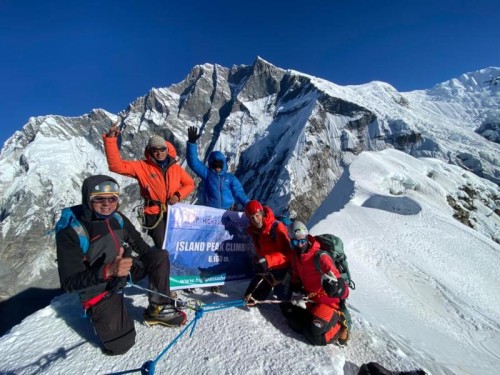


 USD 2250
USD 2250